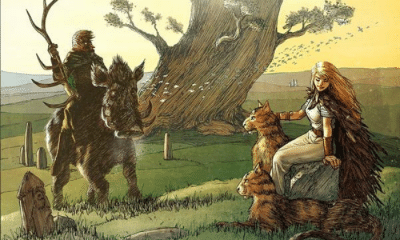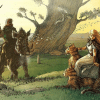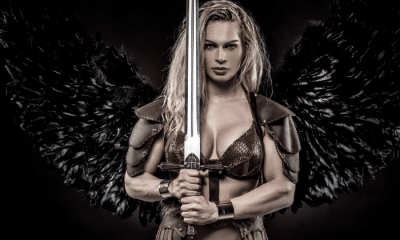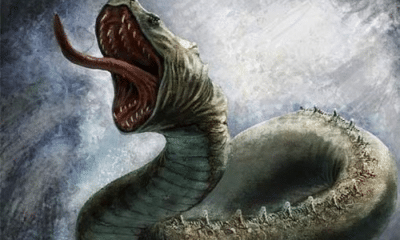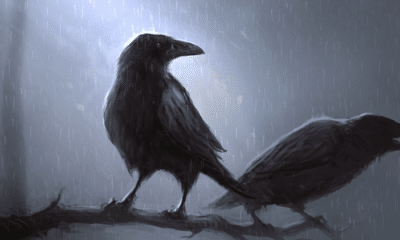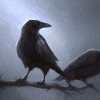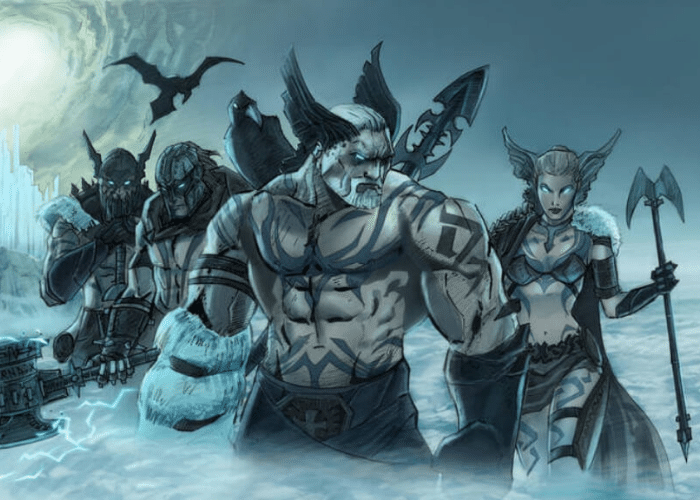
Norse
Who Were the Aesir Gods?
Who Were the Aesir Gods?
The Aesir were the more prominent of the two Norse pantheons. How much do you know about the Aesir gods and what made them unique, though?
The Norse people believed in two groups of gods, the Aesir and the Vanir.
The Aesir are generally considered to be the dominant of the two groups. They appear in more myths, have more detailed stories, and are invoked more often in written records.
In fact, the most popular Vanir gods are often counted among them. The Aesir adopted three of the most well-loved Vanir, so Njörðr, Freyr, and Freyja are often counted as Aesir instead.
The Aesir, specifically their leader Odin, were responsible for the creation of both the world and the human race. While the Vanir were more associated with fertility and prosperity, the Aesir were Norse mythology’s true creator gods.
So how did the Aesir come to be and what distinguished them from the Vanir?
The Unknown Origins of the Aesir Gods
While the Aesir are the most famous of the Norse deities, their origins are somewhat mysterious.
Many other cultures, such as Greece and Egypt, gave detailed family trees and origin stories for their deities. Some gods were even shown as children in various legends.
The Norse, however, seemed to place no such emphasis on their gods’ origins. Only one god’s family history is clearly written in surviving sources.
According to the Norse creation myth, the emptiness of Ginnungagap was all that existed between Muspelheim and Niflheim before the other worlds were created. Eventually, it filled with mist that took shape as the giant Ymir and a great cow named Auðumla.
Auðumla liked the salty ice that dripped off the edge of Niflheim. She made the shape of the first god, Búri. By unknown means, Búri eventually had a son named Borr.
Borr married Bestla, who was either his sister or one of the first jötnar to form from Ymir’s sweat. They had three sons, Odin, Vili, and Vé.
These were the first Aesir gods. They killed Ymir and used his body to create Midgard, the realm of men.
After this, however, the origins of the Aesir gods become unclear.
Vili and Vé disappeared entirely from mythology. While their names were still occasionally mentioned, they no longer played any role in known myths.
The same is true of the gods who preceded them, Búri, Borr, and Bestla. They are not mentioned again except as Odin’s parents.
According to the Prose Edda, by the time humans were created to inhabit Midgard there were at least two other Aesir gods. Odin was joined by Hoenir and Lóðurr in their creation.
Like Odin’s brothers, Lóðurr was also rarely mentioned again. Nor was he given any origin.
The Norse creation story provided an explanation for the world of men and its features, but no such creation story for the other worlds, including those of the gods.
Many of the gods themselves also had no defined origins. Like Lóðurr and Hoenir, they simply appeared alongside Odin when the story required.
Odin’s wife Frigg, for example, has no named parents. It is possible that she was also a child of Bestla and Borr, but no myth makes this explicit.
Only the younger gods, the children of Odin and his peers, are given family relationships. The rest of the Aesir seem to have appeared from nowhere.
The Chief of the Gods
The only Aesir god to be given a full origin story was Odin. This is fitting, as he also became the chief of the Aesir gods.
As with much of the Aesir’s origins, there are no surviving sources that detail how Odin was chosen to lead his people. He was the oldest among them, but many other gods were said to have attributes of leadership and sovereignty.
One of Odin’s epithets was the All-Father, which described his role both among the gods and men.
The people of Midgard called Odin their father because he had been largely responsible for the creation of the human race.
He was also the All-Father to the gods for a variety of reasons.
As their chief, Odin took on a paternalistic role among the Aesir. He could both protect and chastise them when necessary, and like a father could command them to do as he said.
The title was also practical. Many of the most prominent gods were named as children of Odin so, especially since so many Aesir seemed to have no actual family, he was literally the father of much of Asgard’s population.
While the reasons Odin was chosen to rule are not made clear, he soon made himself a good leader.
Odin was known for both his strength in battle and his immense knowledge. Although his search for knowledge often led him away from Midgard and put him in situations that would be shameful for lesser gods, it meant that he had the wisdom and foresight to lead his people well.
The chief of the Aesir became a model for real-world kingship. He was a nearly unmatched warrior, a protector of his people, and constantly expanding his own knowledge of the world.
The War Between the Aesir and Vanir
The Aesir were not the only gods of the Norse people, however.
Another group, called the Vanir, lived in the world of Vanaheim. One of Norse mythology’s most pivotal events was the war between these two groups of gods.
According to some accounts, the Aesir demanded sacrifices from the humans of Midgard and refused to allow the Vanir to have a share, although the Vanir were well-loved by the people.
When a Vanir goddess named Gullveig went to Asgard, the gods there attacked her with spears. Three times she died and was resurrected even though they attempted to burn her body.
Although Gullveig used magic to survive, the attack is still referenced in the Poetic Edda as the inciting event of the Aesir-Vanir War.
This was history’s first war. Odin started the battle by throwing his spear into the midst of the enemy forces, a practice that Norse armies would use to sanctify the battlefield as a site of sacrifices to Odin and the Aesir.
That was yet the battle of armies, the first one in the world.
Odin let fly and shot into the army,
The shield wall of the fortress of the Aesir was broken,
The battle-wise Vanir knew how to tread the field.
-Poetic Edda, Völuspá (trans. Lindow)
While the Aesir were generally regarded as stronger fighters, the Vanir were not an easy opponent to defeat. The Poetic Edda describes them as “wise,” an adjective often used to refer to someone who is skilled in magic.
Although the gods eventually met to determine whether the Aesir should allow the other gods a share of sacrifices or pay a fine outright, Norse writers did not say the Aesir lost outright. Instead, they insisted that the two groups came to an agreement because they were tired of fighting.
In addition to sharing the worship of the humans, the two groups also exchanged members. In this, the Aesir seemed to have fared better.
They sent Hoenir and Mímir to the Vanir, although Mímir was soon beheaded and sent back to Odin. Hoenir was strong and handsome so the Vanir made him their chief, but he lacked the wisdom and decisiveness needed to be a good ruler.
The former leader of the Vanir, Njörðr, went to Asgard. He was joined by his son and daughter, Freyr and Freyja. All three came to be regarded as important Aesir deities despite their Vanir origins.
It is widely believed that Freya introduced the use of magic to the Aesir and started Odin on his path to seek such knowledge. It was eventually said that she was his equal in magic, but that few realized this because she shared much less of the knowledge she had gained.
Snorri’s List of the Gods
Although there was enough division between the Aesir and Vanir gods for them to have gone to war, there is often ambiguity over which group a specific god belongs to.
Classification is especially difficult for the goddesses.
The Norse word ásynja was used to refer to goddesses regardless of which group they belonged to. Sometimes even giantesses were classified as ásynjar.
The group a god belonged to could also change depending on the source. Perhaps the most well-known example of this is Loki.
Loki is often named among the Aesir. Some sources, however, take pains to point of that his father was a jötunn, so he was a giant rather than a god.
Loki’s case is extreme because he became an enemy of the Aesir. For other gods, any confusion is more often due to a lack of defining myths.
To classify the gods more precisely, scholars often turn to the Prose Edda. In addition to Odin and Loki, the first part of the book names a dozen male gods of the Aesir in order of importance. These are:
- Thor – Odin’s son, the thunder god was arguably the most popular in the pantheon. The Prose Edda describes him as “the strongest of all gods and men.”
- Baldr – Another of Odin’s sons, he is described elsewhere as being beautiful and well-loved by every living thing. His death due to Loki’s trickery would be one of the events that set off Ragnarök.
- Njörðr – Although he was once the ruler of the Vanir, the god of prosperity was often listed among the Aesir once he moved to Asgard.
- Freyr – Njörðr’s son was also named among the Aesir. He was a god of peace, fair weather, and the harvest.
- Týr – He was a warrior god, known for his courage. He sacrificed his sword hand to bind Fenrir.
- Bragi – He was a god of poetry and eloquence.
- Heimdall – Born of nine maiden sisters, Heimdall was described as “great and holy.” He watched the Bifröst bridge and would blow his horn to announce the beginning of Ragnarök.
- Höðr – Another of Odin’s sons, the Prose Edda says that the gods wish he never needed to be named. Because he was blind, Loki was able to trick him into killing his brother Baldr.
- Víðarr – One of Odin’s younger sons, he was called the silent god. He would avenge his father’s death by killing Fenrir at Ragnarök.
- Váli – Odin’s youngest son was born, possibly to a human princess, for the sole purpose of avenging Baldr’s death. He did so by killing Höðr.
- Ullr – The Prose Edda calls him Sif’s son, although other sources are less clear. He was a mountain god who was skilled in skiing and archery.
- Forseti – The son of Baldr and Nanna, he settled disputes fairly.
The Prose Edda names Loki as the last of these gods, although it calls him “the originator of deceit, and the disgrace of all gods and men.”
The Aesir as Warriors
In interpreting the gods of Norse mythology, historians often distinguish between the Aesir and Vanir based on their functions.
Norse gods generally had less distinct domains than those of many other religions. Njörðr, for example, is often called “the god of the sea” although he was also generally associated with wealth, fair weather, and justice.
Between the two groups of gods, however, some general differences can be seen in function.
The Vanir are often associated with fertility, prosperity, and magic. The Aesir, meanwhile, were generally associated with warfare, leadership, and power.
Many of the Aesir gods are described in terms of their strength. Even Höðr, who is looked down on for being both blind and the cause of Baldr’s death, is described as “exceedingly strong” in the Prose Edda.
The Aesir are generally shown with the qualities that defined a good leader in Norse society.
Only for Odin did this characterization focus on wisdom and education. Most Aesir gods embodied leadership in their physical strength and skill.
Ullr, for example, is described in the Prose Edda as the god that men should call on in single combat because he was exceptionally fast.
Váli was daring and a good shot. Týr swayed the outcome of battle toward those he favored.
The few Aesir gods who are not associated with warfare are sometimes mocked in literature. When Bragi, the god of poetry, offers to make peace with Loki, the trickster dismisses him as a coward and the last of the gods who waswilling to fight.
The Fate of the Norse Gods
Norse mythology is famous for its prophecy regarding the end of the world. Ragnarök would lead to the deaths of not only most of humanity but the majority of the gods as well.
Many of the greatest Aesir gods would be killed in this final battle. Even Odin would lose his life as he fought the giant wolf, Fenrir.
Some sources seem to indicated that the destruction of the world was the final story in older Norse mths. Later writers, however, expanded the story to give a more positive ending.
In this version of Ragnarök, a handful of gods survived. They would regroup to build Asgard anew and oversee the recreation of Midgard.
Most of the survivors of the Aesir would be younger gods, specifically Odin’s sons.
Baldr and Höðr would both be released from the land of the dead. They would be reconciled and work together in the future.
Váli would survive, as would Víðarr. Víðarr would actually avenge his father’s death by killing Fenrir after both Odin and the Einherjar warriors of Valhalla had fallen.
Odin’s sons would not be the youngest survivors, however. Thor’s sons, Magni and Móði would be there as well.
The only Vanir who are said to survive have links to the Aesir pantheon. Hoenir, who was born as one of the Aesir, and Njörðr who was adopted into Asgard, would be the new leaders of the gods.
Njörðr and Hoenir would depart from tradition, however. They would unite the remaining gods into a single pantheon, eliminating the distinction between the Aesir and Vanir in the new world.
In real life, the fate of the Norse gods was less cataclysmic but led to their destruction nonetheless.
The Norse countries were among the last in Europe to be officially Christianized. They were also among the last to fully remove all traces of their pagan religion.
In fact, some scholars have argued that the Nordic countries never fully lost their pre-Christian folklore. As late as the 19th century, some older people still invoked the Aesir gods in daily life even though they were Christian.
The Aesir gods were also remembered through names in what was once the Norse world, both those of places and people.
Even some modern surnames in English recall the old Norse gods. The surnames Osgood, Osborn, and Oswald all contain the os- root that, in Anglo-Saxon, corresponded to the as- of the Aesir.
These continued connections may be one of the reasons that Nordic religions experienced a resurgence in the 20th century.
For many centuries, Nordic history and folklore were used to instill a sense of national and ethnic pride. The shared heritage of the Nordic and Northern Germanic culture helped to unite the modern countries that had been part of the Norse world.
In the mid-20th century, however, belief in ancient religions began to see a resurgence in many areas. The Norse gods are among those who have attracted a growing number of followers in modern neo-paganist movements.
Today in Denmark, Sweden, Norway, and Iceland the pagan faith of the Norse people is recognized as a legal religion. The Aesir gods are invoked in marriage ceremonies, funerals, and other religious contexts.
While neo-paganism is the religion of a small minority, it still provides cultural ties to the belief of the past. While the Aesir gods may have lost much of their power, the growth of modern paganism shows that they never truly died out in Scandinavia and Iceland.
The Aesir Gods of Asgard
The Aesir gods, defined by their strength and leadership, were the dominant group of deities in the Norse religion.
Odin and his brothers had created the world, while he and other Aesir gods gave life to the first humans. Although most of the gods and their own worlds had no detailed creation stories, they were closely linked to those of the human race.
The Aesir lived on Asgard and were ruled by Odin. In one of Norse mythology’s pivotal events, they went to war with the Vanir gods but eventually made an agreement to coexist.
As part of this truce, the Aesir adopted three of the most popular and powerful Vanir gods into their own pantheon. Njörðr, Freyr, and Freyja had the domains and characteristics of the Vanir but were named among the Aesir because they lived on Asgard.
These were not the only gods who were sometimes difficult to classify. Goddesses were often called by a general term that did not name their grouping and some gods had contradictory associations in different sources.
Loki was also sometimes named as an Aesir and was closely associated with Odin. Many sources, however, pointed out that he was the child of a giant rather than a god, so any place he had among the Aesir was unofficial.
In mythology, the Aesir are largely destroyed in Ragnarök. Their real demise was less apocalyptic, as traditional religion was gradually replaced by Christianity.
In parts of Europe, however, the Norse religion was never fully eradicated. It lived on in descriptive names, folk beliefs, and common phrases for many centuries.
As was foretold in the prophecies of Ragnarök, a handful of Norse gods have survived the end of their kind. Modern neo-paganism is a growing movement that has kept belief in the Aesir gods present in Scandinavia and Iceland in our own time.


